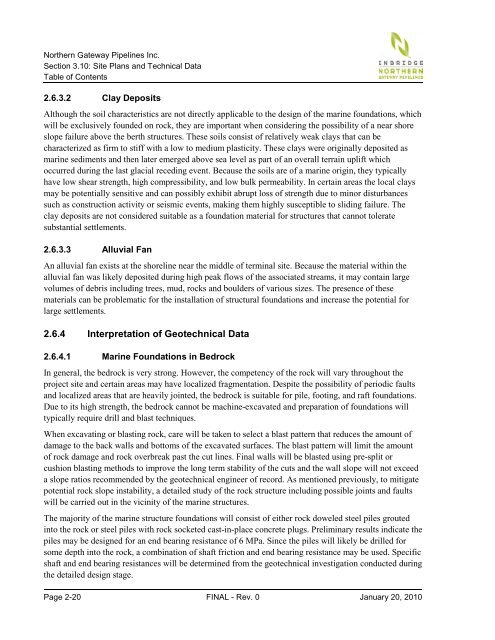Section 3.10: Site Plans and Technical Data - Rick Neufeld Comments
Section 3.10: Site Plans and Technical Data - Rick Neufeld Comments
Section 3.10: Site Plans and Technical Data - Rick Neufeld Comments
Create successful ePaper yourself
Turn your PDF publications into a flip-book with our unique Google optimized e-Paper software.
Northern Gateway Pipelines Inc.<br />
<strong>Section</strong> <strong>3.10</strong>: <strong>Site</strong> <strong>Plans</strong> <strong>and</strong> <strong>Technical</strong> <strong>Data</strong><br />
Table of Contents<br />
2.6.3.2 Clay Deposits<br />
Although the soil characteristics are not directly applicable to the design of the marine foundations, which<br />
will be exclusively founded on rock, they are important when considering the possibility of a near shore<br />
slope failure above the berth structures. These soils consist of relatively weak clays that can be<br />
characterized as firm to stiff with a low to medium plasticity. These clays were originally deposited as<br />
marine sediments <strong>and</strong> then later emerged above sea level as part of an overall terrain uplift which<br />
occurred during the last glacial receding event. Because the soils are of a marine origin, they typically<br />
have low shear strength, high compressibility, <strong>and</strong> low bulk permeability. In certain areas the local clays<br />
may be potentially sensitive <strong>and</strong> can possibly exhibit abrupt loss of strength due to minor disturbances<br />
such as construction activity or seismic events, making them highly susceptible to sliding failure. The<br />
clay deposits are not considered suitable as a foundation material for structures that cannot tolerate<br />
substantial settlements.<br />
2.6.3.3 Alluvial Fan<br />
An alluvial fan exists at the shoreline near the middle of terminal site. Because the material within the<br />
alluvial fan was likely deposited during high peak flows of the associated streams, it may contain large<br />
volumes of debris including trees, mud, rocks <strong>and</strong> boulders of various sizes. The presence of these<br />
materials can be problematic for the installation of structural foundations <strong>and</strong> increase the potential for<br />
large settlements.<br />
2.6.4 Interpretation of Geotechnical <strong>Data</strong><br />
2.6.4.1 Marine Foundations in Bedrock<br />
In general, the bedrock is very strong. However, the competency of the rock will vary throughout the<br />
project site <strong>and</strong> certain areas may have localized fragmentation. Despite the possibility of periodic faults<br />
<strong>and</strong> localized areas that are heavily jointed, the bedrock is suitable for pile, footing, <strong>and</strong> raft foundations.<br />
Due to its high strength, the bedrock cannot be machine-excavated <strong>and</strong> preparation of foundations will<br />
typically require drill <strong>and</strong> blast techniques.<br />
When excavating or blasting rock, care will be taken to select a blast pattern that reduces the amount of<br />
damage to the back walls <strong>and</strong> bottoms of the excavated surfaces. The blast pattern will limit the amount<br />
of rock damage <strong>and</strong> rock overbreak past the cut lines. Final walls will be blasted using pre-split or<br />
cushion blasting methods to improve the long term stability of the cuts <strong>and</strong> the wall slope will not exceed<br />
a slope ratios recommended by the geotechnical engineer of record. As mentioned previously, to mitigate<br />
potential rock slope instability, a detailed study of the rock structure including possible joints <strong>and</strong> faults<br />
will be carried out in the vicinity of the marine structures.<br />
The majority of the marine structure foundations will consist of either rock doweled steel piles grouted<br />
into the rock or steel piles with rock socketed cast-in-place concrete plugs. Preliminary results indicate the<br />
piles may be designed for an end bearing resistance of 6 MPa. Since the piles will likely be drilled for<br />
some depth into the rock, a combination of shaft friction <strong>and</strong> end bearing resistance may be used. Specific<br />
shaft <strong>and</strong> end bearing resistances will be determined from the geotechnical investigation conducted during<br />
the detailed design stage.<br />
Page 2-20 FINAL - Rev. 0 January 20, 2010
















